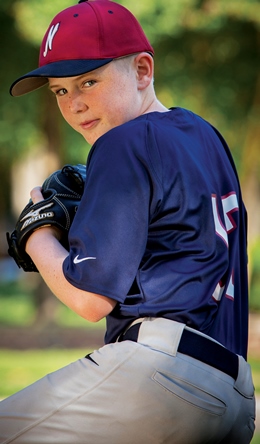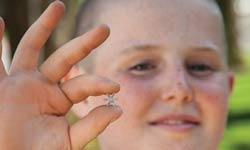Determined to find the cause of her son's breathing problem, Stacy Hennessy sought out the specialists at CHKD.
 Sports are a big part of daily life for the Hennessy family, so it’s not unusual to find 11-year-old Ethan out of breath. The rising sixth-grader plays baseball, basketball, soccer, lacrosse and spends lots of time practicing moves on his skateboard. But when he began wheezing last spring, his mom, Stacy, was concerned.
Sports are a big part of daily life for the Hennessy family, so it’s not unusual to find 11-year-old Ethan out of breath. The rising sixth-grader plays baseball, basketball, soccer, lacrosse and spends lots of time practicing moves on his skateboard. But when he began wheezing last spring, his mom, Stacy, was concerned.
“He kind of sounded like Darth Vader,” says Stacy, explaining that the sound was not associated with overexertion or sports activities. “Just sitting down doing his homework, there was this constant wheezing.”
Ethan’s pediatrician prescribed asthma medication to control the symptoms, but the wheezing persisted.
Determined to get to the bottom of it, Stacy sought out the specialists at CHKD and made an appointment with Dr. Kelly Maples, a pediatric allergy and immunology specialist. During the exam, Dr. Maples took a routine pulmonary function test, which showed that Ethan’s lung function was alarmingly low.
After analyzing Ethan’s past treatments and test results, Dr. Maples knew that his condition was not asthma, and she called on her colleague Dr. Cynthia Epstein, a pediatric pulmonologist at CHKD, to further investigate the cause of his chronic wheeze. Dr. Epstein’s examination included a test for bacteria or fungi that might be infecting his lungs.
Two days later, the Hennessys received an urgent call from Dr. Epstein. Ethan’s test was positive for a potentially dangerous bacteria called pseudomonas. Ethan required a very strong dose of antibiotics and additional tests to determine the cause of the infection.
Ethan began antibiotics to fight the infection and saw Dr. Epstein the following week for a battery of tests, including a sweat test for cystic fibrosis, often associated with the presence of pseudomonas bacteria, and a CT scan for a closer look at his lungs. “Of course, I was a basket case,” Stacy said.
The Hennessys were eating dinner that evening when the phone rang. “Dr. Epstein called and asked if Ethan had ever choked on anything,” Stacy recalls. Ethan couldn’t remember – by now it had been months since his wheezing had started. But Stacy says she wouldn’t have been surprised if he had. “I don’t know how many times I’ve found him chewing on one of his old plastic army guys or a pen cap,” she said.
CHKD’s pediatric radiologists had contacted Dr. Epstein with Ethan’s CT scan results, which showed a foreign object in his right lung. The doctor explained that she would review the scan with one of CHKD’s ear, nose and throat (ENT) specialists to be sure.
Later that night, the Hennessys received a second phone call from CHKD, this time from ENT surgeon Dr. David Darrow, who confirmed the presence of a foreign object on Ethan’s CT scan. While he couldn’t tell exactly what it was, he recommended that Ethan have it removed as soon as possible.
The next day, Ethan arrived at CHKD for an afternoon surgery to remove the mysterious object from his lung. Dr. Darrow would insert a rigid bronchoscope, a lighted tube inserted through the mouth, down the throat and into Ethan’s airway. The tube acts as a passageway through which the doctor accesses areas of the lung using surgical instruments.
“This procedure requires a lot of experience and access to specialized equipment,” says Dr. Darrow, who performs this delicate surgery at CHKD several times each year. “The foreign object can fragment when we try to remove it, or it could get stuck in the airway on the way out, so technique and experience are very important.”
Twenty minutes later, Dr. Darrow met Ethan’s parents in the waiting room with a small plastic bead in hand. Ethan had aspirated a starburst-shaped bead, which measured about a half-inch in diameter, into his right lung.
 Aspiration is a common but serious problem that often begins with an episode of choking. “Most aspiration occurs in children under 3 years old,” Dr. Darrow says. “The most common culprits are nuts, seeds and popcorn kernels.”
Aspiration is a common but serious problem that often begins with an episode of choking. “Most aspiration occurs in children under 3 years old,” Dr. Darrow says. “The most common culprits are nuts, seeds and popcorn kernels.”
Older children tend to aspirate things such as thumb tacks, paper clips, pencil erasers or even small toys. While Ethan doesn’t remember the exact moment he inhaled the bead, Dr. Darrow explains that older children often chew on small objects, gasp unexpectedly and the object gets sucked into the airway.
Aspiration can cause serious complications in children, including breathing problems and infections that can lead to pneumonia. “We know now that the pseudomonas infection was caused by the bead,” Dr. Epstein says. “The bacteria was growing in the mucus in Ethan’s lungs and couldn’t get out because the bead was in the way.”
Dr. Darrow explains that an aspiration diagnosis such as Ethan’s was difficult to make for a few reasons. First, plastic objects don’t cause a lot of tissue reaction like particles of food do, so symptoms are often less severe. Second, the shape of the bead allowed air to move around it. As long as an object doesn’t block the airway completely, it can go undiagnosed for a very long time, causing symptoms that sound a lot like asthma.
While it may have been a challenging diagnosis, Stacy is grateful for the CHKD physicians who worked together to help solve the mystery and prevent a more serious situation for her son. Since his surgery, Ethan’s lung function has improved, and his wheeze has disappeared. “It caused a lot of anxiety, that’s for sure,” said Stacy, who, along with Ethan, is breathing a bit easier now thanks to the teamwork of CHKD specialists.
Drs. Kelly Maples and Cynthia Epstein practice with Children's Specialty Group, PLLC, at CHKD. Dr. David Darrow practices with EVMS ENT at CHKD.